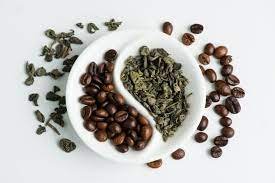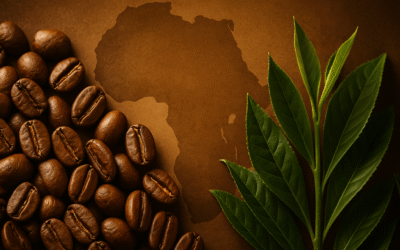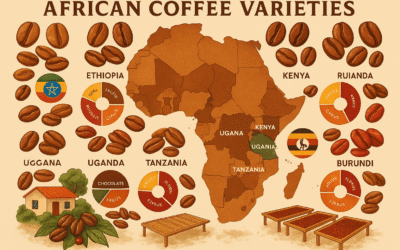Africa’s diverse growing regions produce some of the world’s most distinctive coffee varieties, from Ethiopia’s aromatic heirloom Arabicas to Uganda’s bold Robustas, each offering unique flavor profiles shaped by local terroir, processing methods, and centuries of cultivation.
Introduction: Africa’s Coffee Diversity Landscape
Africa stands as the ancestral homeland of coffee, where thousands of varieties have evolved across diverse landscapes—from Ethiopia’s highland forests to Rwanda’s volcanic soils. This rich genetic diversity represents not just agricultural heritage but also holds the key to coffee’s future resilience and distinctive flavor potential.
While the industry often simplifies to just “African coffee,” the continent produces an extraordinary range of varieties with vastly different characteristics. Each region’s unique combination of elevation, climate, soil composition, and processing traditions creates coffees that are impossible to replicate elsewhere.
As the
Africa Coffee & Tea Expo 2025 prepares to showcase this diversity in Kigali this July, this guide explores Africa’s major coffee varieties and their regional expressions—essential knowledge for everyone from casual coffee enthusiasts to industry professionals.
Ethiopia: The Birthplace of Genetic Diversity
Heirloom Varieties: Coffee’s Original Source
Featured Snippet: Major Coffee Varieties of Africa by Region
- Ethiopia: Heirloom varieties (Gesha, Yirgacheffe, Sidamo, Harar), thousands of uncatalogued landraces
- Kenya: SL28, SL34, Ruiru 11, Batian, K7
- Rwanda: Bourbon, Jackson, Mbirizi, RAB C15
- Tanzania: N39, KP423, Bourbon derivatives
- Uganda: SL14, SL28, Bugisu Arabica, Robusta Nganda and Erecta
- Burundi: Bourbon, Jackson, Mibirizi
- DR Congo: Bourbon, Caturra, Kabare 2
Ethiopia’s coffee landscape remains unique globally, with thousands of uncatalogued “heirloom” varieties growing across diverse ecosystems. Unlike most producing countries that rely on a handful of cultivars, Ethiopian coffee represents the greatest genetic diversity within the Arabica species.
“What makes Ethiopia exceptional is that many of these varieties evolved naturally over centuries, developing distinctive characteristics through natural selection,” explains Abdullah Bagersh, General Manager of SA Bagersh PLC and Ethiopian coffee expert.
The renowned Gesha variety (also spelled Geisha), which commands record prices when grown in Panama, originated in Ethiopia’s southwestern forests. However, countless other Ethiopian varieties offer equally remarkable cup profiles, from the floral and citrus notes of Yirgacheffe to the wild berry and chocolate characteristics of Harar.
Tasting notes: Distinctive blueberry and jasmine in natural-processed varieties; bergamot, lemon, and black tea in washed processing; distinctive wine-like fermented notes in traditional Harar dry-processing.
Kenya: Scientific Selection for Exceptional Quality
SL Varieties and Modern Hybrids
Kenya took a different approach to variety development, establishing formal research programs in the mid-20th century. The renowned Scott Laboratories (SL) varieties—particularly SL28 and SL34—were selected from earlier Bourbon introductions for their exceptional cup quality and moderate disease resistance.
“SL28 remains the crown jewel of Kenyan coffee, known for its remarkable acidity and blackcurrant notes that are immediately recognizable to experienced cuppers,” notes Martin Shabaya, three-time Africa Barista Champion.
Newer varieties like Ruiru 11 and Batian were developed by the
Coffee Research Institute to combine disease resistance with quality characteristics, helping farmers combat coffee leaf rust and coffee berry disease while maintaining Kenya’s reputation for exceptional quality.
Tasting notes: Vibrant, wine-like acidity; distinctive blackcurrant and redcurrant flavors; tomato-like savory notes; full, syrupy body; complex black fruit sweetness.
Rwanda and Burundi: Bourbon Renaissance
High-Altitude Bourbon Derivatives
Rwanda and Burundi share similar growing conditions and variety portfolios, with various Bourbon types dominating production. These Central African nations benefit from ideal growing conditions, with elevations often exceeding 1,800 meters and rich volcanic soils.
“Rwandan Bourbon varieties express themselves differently than those in Latin America, with distinctive floral notes and a fascinating orange blossom characteristic rarely found elsewhere,” explains Jean Aime Niyonkuru, Executive Manager of
Sustainable Growers / Question Coffee.
In recent years, Rwanda has introduced improved varieties like RAB C15, which maintains Bourbon’s quality while offering better resistance to climate stressors—a critical adaptation as the region experiences climate change impacts.
Tasting notes: Delicate orange blossom and black tea aromas; bright citrus acidity; distinctive red apple and caramel sweetness; silky, elegant mouthfeel; clean, sweet finish.
Uganda: Bridging Arabica and Robusta Excellence
Specialty Robusta and Highland Arabica
Uganda stands unique among African producers for its dual excellence in both Arabica and Robusta production. While many countries produce both species, Uganda has pioneered specialty Robusta cultivation, challenging perceptions about this often-overlooked species.
“Uganda’s Robusta grows at elevations up to 1,500 meters—significantly higher than most global Robusta production,” notes Robert Kobushenga, Ugandan farmer and coffee entrepreneur. “This elevation, combined with specific processing protocols, creates a completely different cup profile than typical Robustas.”
In Uganda’s Arabica sector, varieties like SL14 and SL28 thrive in the country’s eastern highlands, particularly in the Bugisu region near Mount Elgon, producing distinctive coffees with loyal followings among specialty roasters.
According to the
Uganda Coffee Development Authority, the country’s diverse variety portfolio represents a strategic advantage as climate change affects growing regions differently.
Tasting notes:
- Arabica: Tropical fruit sweetness, tamarind acidity, chocolate and spice finish
- Specialty Robusta: Impressive body, mild earthiness, dark chocolate, distinctive woody spice notes
Tanzania: Classic Varieties in Iconic Regions
N39 and Bourbon Types
Tanzania’s coffee identity centers on the iconic northern regions around Mount Kilimanjaro and the southern highlands near Mount Rungwe. The country’s primary varieties include N39 (a Kent derivative) and various Bourbon types that excel in these high-altitude environments.
“Tanzanian varieties express remarkable clarity and definition in their flavor profiles,” says Sara Yirga, Rwanda Chapter Head of the International Women’s Coffee Alliance (IWCA). “The peaberry sorting common in Tanzania—where single rather than twin seeds develop in the cherry—further intensifies these characteristics.”
The
Tanzania Coffee Board has recently invested in developing climate-resilient varieties while preserving the cup characteristics that define Tanzanian coffee’s reputation in specialty markets.
Tasting notes: Bright, black tea-like quality; distinctive stone fruit flavors; blackberry sweetness in southern regions; clean, wine-like finish; medium body with vibrant acidity.
Emerging Varieties: Climate Resilience Meets Quality
New Crossbreeds for Changing Conditions
Climate change has accelerated variety development across Africa, with research institutions and private companies working to create varieties that maintain quality while withstanding new stresses.
“The future of African coffee varieties lies at the intersection of climate resilience, disease resistance, and exceptional cup quality,” explains Dr. Agnes Kalibata, former Rwandan Minister of Agriculture and President of AGRA.
According to the
International Coffee Organization, African research institutions are at the forefront of developing varieties that can withstand both biotic stresses (pests/diseases) and abiotic stresses (heat/drought) while maintaining the distinctive characteristics that make African coffees irreplaceable in the global market.
Conclusion: Africa’s Variety Renaissance
Africa’s coffee variety landscape represents both living history and innovation frontier. From Ethiopia’s thousands of heirloom varieties to Kenya’s scientifically selected cultivars, these genetic resources embody centuries of adaptation and selection that have created the continent’s distinctive cup profiles.
For coffee professionals, understanding these varieties provides crucial context for sourcing, roasting, and brewing decisions. For consumers, this knowledge opens doors to appreciating the remarkable diversity of flavors available from across the continent.
The upcoming
Africa Coffee & Tea Expo 2025 in Kigali will showcase many of these varieties through cupping sessions and technical presentations, providing a unique opportunity to experience Africa’s variety diversity firsthand while connecting with producers preserving and advancing this precious genetic heritage.
Whether you’re a specialty roaster seeking distinctive profiles, a barista crafting educational experiences, or simply a coffee lover exploring new flavor frontiers, Africa’s coffee varieties offer an unparalleled journey through coffee’s past, present, and future.
Are you working with specific African coffee varieties or want to learn more about a particular region’s coffees? Share your experiences or questions in the comments below, or contact us to suggest varieties for our upcoming tasting series. 




